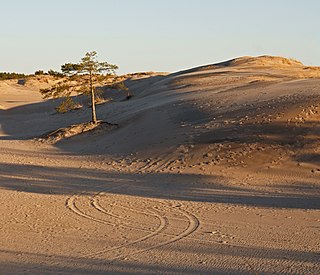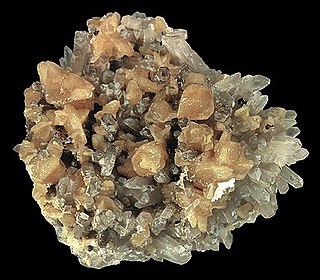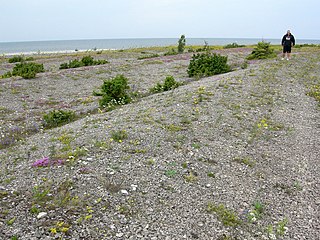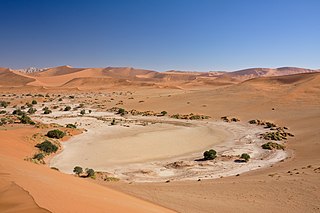Related Research Articles

A dune is a landform composed of wind- or water-driven sand. It typically takes the form of a mound, ridge, or hill. An area with dunes is called a dune system or a dune complex. A large dune complex is called a dune field, while broad, flat regions covered with wind-swept sand or dunes with little or no vegetation are called ergs or sand seas. Dunes occur in different shapes and sizes, but most kinds of dunes are longer on the stoss (upflow) side, where the sand is pushed up the dune, and have a shorter slip face in the lee side. The valley or trough between dunes is called a dune slack.

Monazite is a primarily reddish-brown phosphate mineral that contains rare-earth elements. Due to variability in composition, monazite is considered a group of minerals. The most common species of the group is monazite-(Ce), that is, the cerium-dominant member of the group. It occurs usually in small isolated crystals. It has a hardness of 5.0 to 5.5 on the Mohs scale of mineral hardness and is relatively dense, about 4.6 to 5.7 g/cm3. There are five different most common species of monazite, depending on the relative amounts of the rare earth elements in the mineral:
Chandipura vesiculovirus (CHPV) is a member of the Rhabdoviridae family that is associated with an encephalitic illness in humans. It was first identified in 1965 after isolation from the blood of two patients from Chandipura village in Maharashtra state, India and has been associated with a number of otherwise unexplained outbreaks of encephalitic illness in central India. The most recent occurred in Andhra Pradesh and Maharashtra in June–August 2003 with 329 children affected and 183 deaths. Further sporadic cases and deaths in children were observed in Gujarat state in 2004.

A beach ridge is a wave-swept or wave-deposited ridge running parallel to a shoreline. It is commonly composed of sand as well as sediment worked from underlying beach material. The movement of sediment by wave action is called littoral transport. Movement of material parallel to the shoreline is called longshore transport. Movement perpendicular to the shore is called on-offshore transport. A beach ridge may be capped by, or associated with, sand dunes. The height of a beach ridge is affected by wave size and energy.

Sossusvlei is a salt and clay pan surrounded by high red dunes, located in the southern part of the Namib Desert, in the Namib-Naukluft National Park of Namibia. The name "Sossusvlei" is often used in an extended meaning to refer to the surrounding area, which is one of the major visitor attractions of Namibia.

The Z710 is a mobile phone produced by Sony Ericsson

Seismic base isolation, also known as base isolation, or base isolation system, is one of the most popular means of protecting a structure against earthquake forces. It is a collection of structural elements which should substantially decouple a superstructure from its substructure that is in turn resting on the shaking ground, thus protecting a building or non-building structure's integrity.

Sand is a granular material composed of finely divided rock and mineral particles. Sand has various compositions but is defined by its grain size. Sand grains are smaller than gravel and coarser than silt. Sand can also refer to a textural class of soil or soil type; i.e., a soil containing more than 85 percent sand-sized particles by mass.

Hangklip Sand Fynbos is an endangered vegetation type that occurs in the southern coastal portion of the Western Cape, South Africa.
The geology of Essex in southeast England largely consists of Cenozoic marine sediments from the Palaeogene and Neogene periods overlain by a suite of superficial deposits of Quaternary age.

Glaciofluvial deposits or Glacio-fluvial sediments consist of boulders, gravel, sand, silt and clay from ice sheets or glaciers. They are transported, sorted and deposited by streams of water. The deposits are formed beside, below or downstream from the ice. They include kames, kame terraces and eskers formed in ice contact and outwash fans and outwash plains below the ice margin. Typically the outwash sediment is carried by fast and turbulent fluvio-glacial meltwater streams, but occasionally it is carried by catastrophic outburst floods. Larger elements such as boulders and gravel are deposited nearer to the ice margin, while finer elements are carried farther, sometimes into lakes or the ocean. The sediments are sorted by fluvial processes. They differ from glacial till, which is moved and deposited by the ice of the glacier, and is unsorted.
Nonlabens is a Gram-negative, strictly aerobic, non-spore-forming and non-motile genus of bacteria from the family of Flavobacteriaceae.
Nonlabens aestuariivivens is a Gram-negative, aerobic and non-motile bacterium from the genus of Nonlabens which has been isolated from tidal flat from Oido.
Nonlabens agnitus is a bacterium from the genus of Nonlabens.
Nonlabens antarcticus is a Gram-negative, strictly aerobic, psychrophilic and rod-shaped bacterium from the genus of Nonlabens which has been isolated from the core of a glacier from the King George Island.
Nonlabens dokdonensis is a Gram-negative, non-spore-forming, rod-shaped and non-motile bacterium from the genus of Nonlabens which has been isolated from sea water.
Nonlabens halophilus is a Gram-negative, aerobic, non-spore-forming, rod-shaped and non-motile bacterium from the genus of Nonlabens.
Nonlabens marina is a Gram-negative, aerobic and rod-shaped bacterium from the genus of Nonlabens which has been isolated from seawate from the Pacific Ocean.
Nonlabens spongiae is a Gram-negative, strictly aerobic, rod-shaped and motile bacterium from the genus of Nonlabens which has been isolated from a marine sponge from the Bahamas.
Nonlabens ulvanivorans is a Gram-negative, strictly aerobic, rod-shaped, chemoorganotrophic and non-motile bacterium from the genus of Nonlabens which has been isolated from the faeces of the sea slug Aplysia punctata.
References
- 1 2 "Species: Nonlabens arenilitoris". LPSN.DSMZ.de.
- 1 2 Park, Sooyeon; Kang, Chul-Hyung; Yoon, Jung-Hoon (May 2013). "Nonlabens arenilitoris sp. nov., a member of the family Flavobacteriaceae isolated from seashore sand". Antonie van Leeuwenhoek. 103 (5): 1125–1132. doi:10.1007/s10482-013-9893-5. PMID 23423354. S2CID 17942919.
- ↑ "Nonlabens arenilitoris". www.uniprot.org.